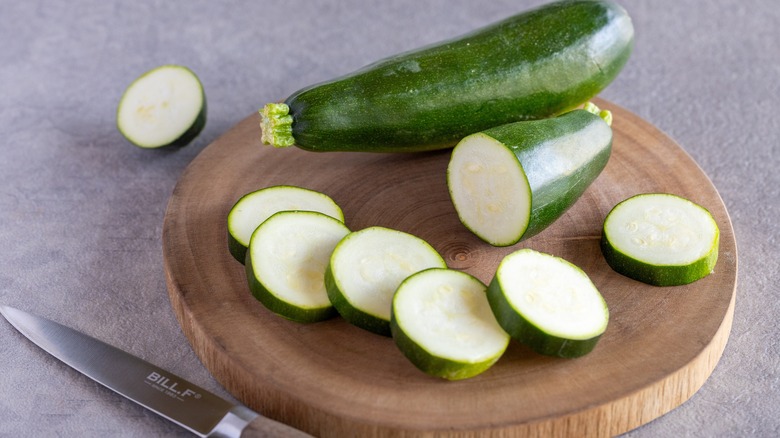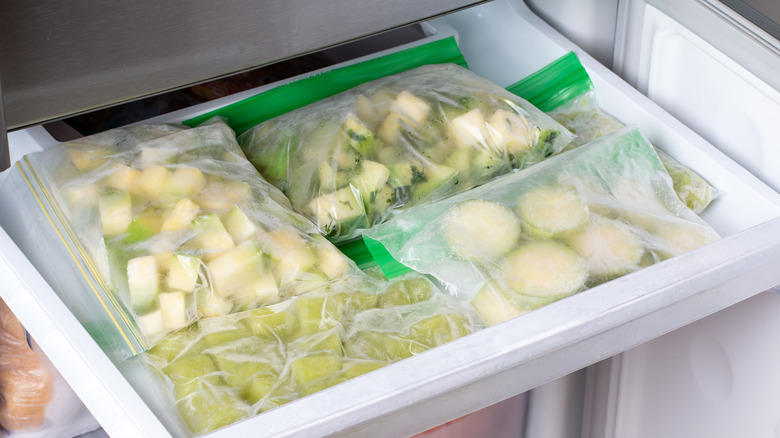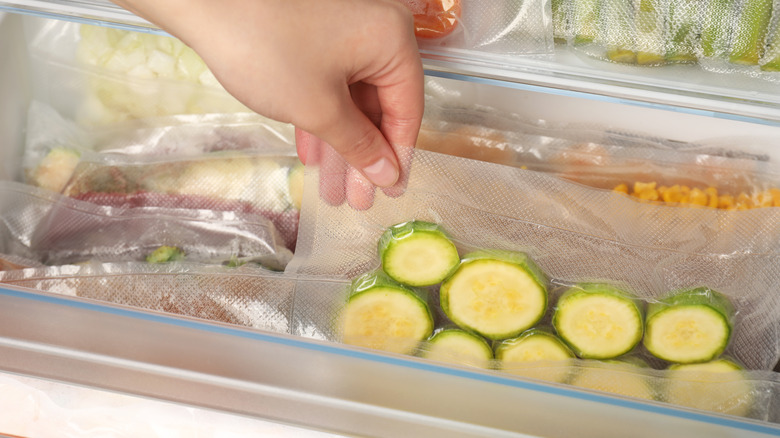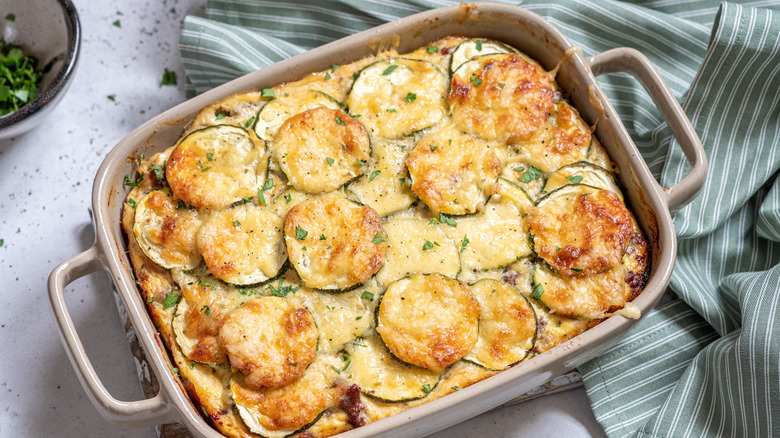The Best Way To Store Leftover Cut And Uncut Zucchini
Zucchini is dearly loved thanks to its versatility in creating a wide range of dishes. That means, if you find yourself with more than you can use in one sitting, keeping the leftovers fresh is your number one goal so you can create other delicacies later on. Whether they're whole or cut into pieces, the simplest storage solution for zucchini is refrigeration.
For whole (uncut) zucchinis, keep them in the crisper drawer of your fridge. Avoid the common storage mistake of washing the veggies before refrigeration; instead, put them in a plastic bag as-is and leave the top open, or use a perforated plastic bag to maintain sufficient air circulation. This way you'll avoid moisture accumulation — one of the leading causes of spoilage. Your zucchini will last around one or two weeks when stored this way.
If your leftovers are already cut, stash the pieces in an airtight container or seal them in a ziplock bag and put them in the fridge crisper drawer. In cut form, zucchini is more delicate, so use them within four to five days for the best texture and flavor. However, if you have spiralized them to make zoodles, these aren't ideal for storing because they can quickly get soggy. It's better to find another use for them immediately.
Anytime you store zucchini, be sure to check for spoilage before using it in your next dish. This can include excessive bruising, brown or soft softs, and mushiness. Also look out for mold or strong odors — all signs that the vegetable is past its prime.
Freeze zucchini for even longer storage
If the amount of zucchini you have will take you more than a couple of weeks to cook and eat, then freezing is the best option. This will require a few extra steps because you can't just freeze whole raw zucchinis as they will turn very soggy after thawing. Start by chopping the squash. Depending on how you plan to use it later, you can cut it into slices, spears, or cubes. Next is blanching — this is a freezer storage trick that'll make the squash retain its vibrant color and most of its original texture when frozen.
Boil water in a pot on the stovetop, then add the zucchini pieces and give them about two to three minutes to cook. Once your timer goes off, remove the vegetables and transfer to an ice bath which is simply a bowl of cold water with ice inside. The cold temperature will shock the squash and halt the cooking so the pieces don't overcook. Give them a few minutes to completely cool, then drain and pat dry.
The last step is flash freezing. Arrange the blanched and cooled zucchini on a lined baking sheet. Pop them in the freezer for about two hours. Now they're ready to be transferred to a resealable freezer bag; be sure to remove as much air as possible before sealing. Label with the date and the name of the item then store in the freezer to be used within about three to six months.
How to defrost frozen zucchini
Once you're ready for a meal with zucchini, it's time to defrost the squash. But first, consider how you plan on using it. If you're making casseroles, stews, or soups, there's really no need for thawing first. Simply add the frozen pieces directly to the pot or baking dish with the rest of the ingredients, and they'll automatically thaw and cook.
On the other hand, if the dish requires thawing the zucchini first, the best method to go about it is refrigeration. Transfer the frozen zucchini from the freezer to the fridge the day (or at least a few hours) before you want to use it, so it can thaw slowly. The good thing about this thawing method is that it's hands-off, however, the fact that you have to plan for it in advance is a bit limiting.
So what if you forgot to transfer the frozen zucchini to the fridge the night before? There's a quicker thawing method: Put the frozen squash under cold running water. This will take just a few minutes and your zucchini will be ready for cooking. Be warned, though, that the texture of thawed zucchini won't be exactly the same as fresh because freezing and then thawing releases more moisture. Even so, there are several ways you can cook this zucchini to create a delicious spread.
Delicious ways to use leftover zucchini
There are plenty of recipes to try out when it comes to cooking leftover cut and uncut zucchini, whether it's the defrosted batch from your freezer or the fresh ones that you stored in the crisper drawer. One of our favorites is frying them. All you need is a mixture of panko and parmesan cheese for the breading to coat the veggie strips. Then they go into the scalding-hot deep fryer oil to make a perfectly crispy and tasty appetizer.
Prefer something heartier? Zucchini makes the meanest vegetable-based casseroles or fritters around — crunchy on the outside, super creamy and soft on the inside. Make an even more unique dish by taking that whole zucchini you had stored in the crisper and cutting it into cute spirals for zoodles, the ultimate low-carb alternative to pasta. All you need is a light saute with cooking oil, some aromatics, and your favorite sauce.
Other great zucchini recipes you should try are those that involve baked goods. Did you know that zucchini is the vegetable that makes cakes (and other baked goods) unbelievably tender? Just add the squash to your breads, cakes, and muffin batters, and thank us later. It's a clever way of adding veggies to your diet without sacrificing flavor. All in all, properly storing zucchini — whether whole, cut, fresh, or frozen — can extend its shelf life and give you plenty of opportunities to enjoy it in a variety of recipes.



